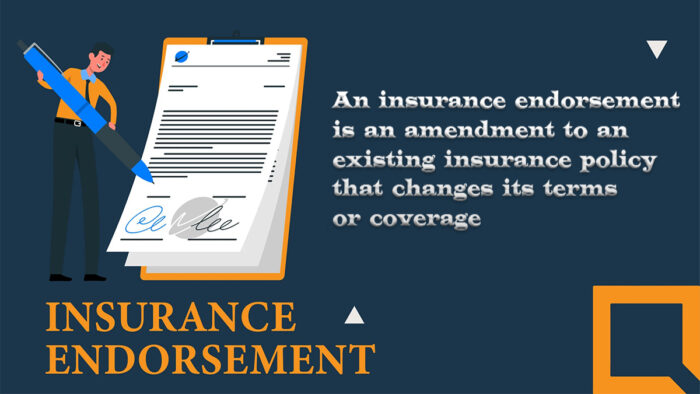An insurance endorsement, sometimes referred to as a rider or an addendum, is a legal modification to an existing insurance policy that changes its terms or coverage. This flexible tool allows policyholders to adjust their insurance coverage to better suit their specific needs, circumstances, or changes in risk without having to issue a new policy entirely.

Apart from this, insurance endorsements can be used to add, delete, or otherwise alter the coverage provided by the policy, giving a customized insurance solution that reflects the unique aspects of the policyholder’s situation.
Furthermore, endorsements are commonly used across various types of insurance policies, including homeowners, auto, life, and business insurance. They can serve multiple purposes, such as increasing coverage limits, extending coverage to additional risks or assets, or excluding certain types of coverage.
For instance, a homeowner might add an endorsement to their policy to cover a valuable piece of jewelry, or a business owner might use an endorsement to include coverage for a new piece of equipment.
In the meantime, the process of adding an endorsement typically involves discussing the desired changes with the insurance company or insurer, who will then issue the endorsement to be attached to the existing policy.
Accordingly, this amendment or change becomes a legal part of the insurance contract, and it may affect the policy’s premium, depending on the nature of the change. By providing a means to customize and adjust coverage as needed, insurance endorsements play a significant role in ensuring that policies remain relevant and effective in protecting against the risks faced by policyholders.
How Does It Work?
When a policyholder or insurer identifies the need for changes to an insurance policy, an endorsement can be issued. This might occur for various reasons, such as acquiring new assets, needing additional coverage due to changes in risk, or correcting information on the policy.
The endorsement is documented in writing and becomes part of the insurance contract, legally amending the policy terms.
Once agreed upon, the insurer will issue the endorsement, which outlines the specific alterations made to the policy. It is important for policyholders to review any endorsement carefully to understand how their coverage is affected. Depending on the change, the endorsement might lead to an adjustment in the policy’s premium.
Types of Insurance Endorsement
There are four main types of insurance endorsements. We will be learning more about them below, so keep scrolling if you are interested:
- Standard endorsements
- Non-standard endorsements
- Mandatory endorsements
- Voluntary endorsements
• Standard endorsements
These are pre-defined by the insurer and address common changes that policyholders may need. For instance, in home insurance, a common endorsement might provide coverage for a home business, which is not typically covered under a standard policy.
• Non-standard endorsements
These are customized to the policyholder’s specific needs and are drafted to address unique situations or risks not covered by standard endorsements. An example might be a valuable art collection that requires additional coverage beyond what is offered in a standard homeowners policy.
• Mandatory endorsements
Mandatory insurance endorsements are alterations to an insurance policy that are required by state law or regulatory bodies. These adjustments are non-negotiable and must be included in the policy to ensure compliance with legal standards and protections.
The purpose of mandatory endorsements is often to provide minimum levels of coverage for specific risks that the law deems necessary for public welfare or to protect consumers from specific, widespread risks.
Voluntary endorsements
Voluntary insurance endorsements, on the other hand, are optional modifications that policyholders can choose to add to their policies to enhance or extend their coverage according to their personal needs or concerns. These endorsements allow policyholders to customize their insurance policies beyond the standard coverage, tailoring them to cover specific assets, activities, or potential liabilities that are not covered under the basic policy terms.
Do I Need One?
Determining whether you need an insurance endorsement depends on several factors:
- Changes in Risk: If your lifestyle or business undergoes significant changes that could affect your risk profile, an endorsement may be necessary to ensure adequate coverage.
- Valuable Assets: If you acquire valuable assets not covered under your existing policy, endorsements can provide the necessary protection.
- Name or Address Change: If you still want to keep your existing insurance quote even if you are moving, the insurance company may support the use of an insurance endorsement.
In conclusion, whether or not you need an insurance endorsement is determined by your financial situation.
How to Get Insurance Endorsement
Obtaining an insurance endorsement involves the following steps:
- Review your current policy: Understand your existing coverage to identify any gaps or areas that need modification.
- Contact your insurance provider: Discuss your needs with your insurance agent or a company representative. They can advise you on the types of endorsements available and what might be best for your situation.
- Provide Necessary Information: Depending on the endorsement, you may need to provide additional information or documentation.
- Review the Endorsement: Once issued, carefully review the endorsement to ensure it meets your needs and understand any changes to your premium.
- Approval and Implementation: After reviewing, approve the endorsement. It will then become part of your policy, modifying your coverage as agreed.
With help from these steps, you will be able to get an insurance endorsement with so much ease and using straightforward steps or procedures.
FAQs
What types of changes can be made with an insurance endorsement?
Insurance endorsements can be used to make various changes to your policy, including adding or removing coverage, changing policy limits, updating beneficiary information, or modifying policy terms and conditions.
Is there an additional cost for insurance endorsements?
Yes, there may be an additional cost associated with insurance endorsements, depending on the changes being made to your policy. Adding more coverage or increasing policy limits typically results in higher premiums, while reducing coverage may lead to lower premiums.
Are there any limitations to insurance endorsements?
While insurance endorsements offer flexibility in customizing your policy, there may be limitations on the types of changes you can make or the extent of coverage available through endorsements. It’s important to discuss your needs and options with your insurance provider.
Can insurance endorsements be canceled or removed?
Yes, insurance endorsements can typically be canceled or removed from your policy at any time, subject to the terms and conditions set forth by your insurance provider. However, removing an endorsement may impact your coverage, so it’s essential to consider the implications before making any changes.
Do insurance endorsements expire?
Insurance endorsements generally remain in effect for the duration of your policy term, unless otherwise specified. However, some endorsements may have specific expiration dates or renewal requirements, so it’s crucial to review your policy documents carefully.



